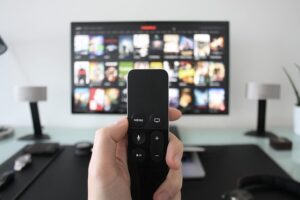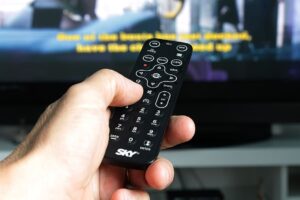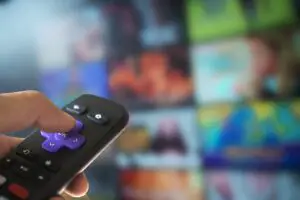If your TV is turning on but you’re not getting any picture, don’t worry; you’re not alone. This is a common issue that many people encounter regardless of their TV brand or model.
At first, like most people, I thought there was a serious hardware problem with my TV, and I feared it might be irreparable. However, the solution turned out to be much simpler than expected. Here’s what you can do to get your picture back:
Perform a soft reset on your television. Start by unplugging your TV from the wall outlet. While the TV is still unplugged, press and hold down the power button on the TV for a continuous 15 seconds. After that, release the power button and wait for another 30 seconds before plugging the TV back into the wall outlet.
This soft reset can often resolve issues where the TV powers on but doesn’t display a picture. It’s a straightforward troubleshooting step that can save you from unnecessary worries and potential repair costs.
Perform a Soft Reset on Your TV
Performing a soft-reset on your TV is a crucial step that should not be overlooked whenever you encounter technical issues. This simple yet effective troubleshooting method can often resolve various problems without causing any data loss.

Follow these steps to perform a soft-reset on your TV:
- Start by unplugging your TV from the wall outlet.
Note: Ensure that your TV is not plugged into a surge protector, as these can sometimes cause power-related issues.
- While the TV is unplugged, locate the power button on your TV. Press and hold the power button for approximately 15 seconds.
Important: Use the power button on the TV itself, not the remote. TVs have capacitors that store excess power, even when unplugged. Holding the power button drains these capacitors, allowing for a complete reset.
- After the 15 seconds, release the power button and then wait for about 30 seconds before plugging your TV back into the wall outlet.
In most cases, following these three simple steps will resolve the issue and restore your TV’s picture. However, if the problem persists, continue reading for further troubleshooting.
Check All TV Connections
If the soft-reset didn’t resolve the issue with your TV, follow these steps to double-check and troubleshoot the connections:
- Start by disconnecting all external devices from your TV. Wait for about 30 seconds, and then reconnect each device. Ensure that every connection is securely plugged in.

Note: In modern setups, multiple external devices like streaming devices (Roku, Firestick, Chromecast), game consoles (PlayStation, Xbox), or cable boxes are commonly connected to the TV. Loose connections between these devices and the TV can cause display problems.
- Try connecting your external device to a different HDMI port on your TV. While not very common, HDMI ports can fail over time. If you’re using “HDMI 1” for your cable box and experiencing display issues, try using “HDMI 2” or other available HDMI ports to see if the problem persists.
- Inspect each cable or cord for any signs of damage. If you suspect a faulty cord, try using a different one of the same type if available. For example, if your cable box uses an HDMI cord, test with another HDMI cord to see if it resolves the issue.
- Ensure your TV is on the correct input/source channel when using an external device. Most external devices connect to the TV via HDMI, and each HDMI port on the back of your TV is assigned a corresponding number. If your cable box is connected to “HDMI 1” but the TV is on the “HDMI 2” input, you won’t see an image on the screen. Use your TV remote to press the input/source button and toggle through the channels until you find the right one.
By carefully checking and troubleshooting the connections, you can often resolve display problems with your TV and enjoy your favorite content again.
Use an Alternate External Device
If you’re experiencing a sound but no picture issue on your TV when using an external device like a cable box or a game console, it’s essential to troubleshoot the problem and determine if the cause lies with the external device or your TV. Here’s what you can do:
- Disconnect the external device that is causing the issue from your TV. Instead, try using a different external device or use the TV without any external devices connected.
Note: If you get a picture on your TV after disconnecting the specific external device, it’s a strong indication that your TV is functioning correctly, and the problem lies with the disconnected device.
This simple test can help you identify whether the issue is with your TV or the external device. If the TV is working fine with other devices or without any external devices, you can focus on troubleshooting or replacing the problematic device to restore the picture on your TV.
Hardware Issues
If you’ve exhausted all the previous fixes and your TV’s picture is still not working, it’s probable that your TV is facing a hardware issue. To diagnose the specific hardware problem, follow these steps:

- Check the Backlight: Turn off the lights in the room and power on your TV. Look at the back of the television through the vent to see if you notice any light shining through. If you see light, it indicates that the “backlight” of your TV is still functioning. In this case, the problem is likely with the T-Con board or main board (motherboard). You can start by replacing the T-Con board, as it often resolves the issue.
- Verify the Backlight Function: If you did not see any lights in the previous step, it means your backlight is not working. Turn off the lights again, ensure your TV is “ON,” and access the TV menu. Take a flashlight and shine it on the screen, looking for signs of the menu. Move the flashlight around a few inches from the screen until you can faintly make out the TV menu. If you can see the image with the flashlight, it indicates that your T-Con board and main board are likely fine, but the inverter or LED driver may be faulty. Some TV models have the inverter/LED driver integrated into the power-supply board, requiring you to replace the entire power board.
Please note that diagnosing and fixing these hardware issues will involve disassembling your TV, which can be complex and may require professional assistance. If you’re not confident in performing these repairs yourself, it’s best to seek the help of a qualified technician.
Contact Customer Support
If you’ve tried all the troubleshooting steps and couldn’t get your TV’s picture to work, I recommend reaching out to customer support before giving up. Many TV brands provide various support options, ranging from in-home repairs to mail-in services.
When contacting support, consider the cost of the repair as a crucial factor. Technicians will typically diagnose the issue and present you with repair options before any payment is required. However, it’s important to be aware that nowadays, many TV repairs can be more expensive than purchasing a new TV.

Before making a decision, weigh the repair cost against the price of a new TV and consider the age and overall condition of your current TV. Sometimes it may be more cost-effective to invest in a new TV, especially if your current one is older or has other underlying issues.
Ultimately, customer support can guide you through the available options and help you make an informed decision based on your specific situation.
Verify Your Warranty
You can also check online to see if your TV is still covered by the manufacturer’s warranty. Although most warranties typically last for only one year, it’s still worth investigating if your TV might still be eligible for coverage.
Wrapping it up
If there is no picture on your TV, you can try the following fixes in this exact order:
- Soft-reset your TV.
- Make sure all your TV’s connections are secure.
- Test a different externally connected device.
- Check for hardware issues: a. Replace the T-Con board. b. Replace the main board. c. Replace the power-supply board. d. Replace the LED strips.
- Reach out to support for further assistance.
- Look into your TV’s warranty to see if it’s still covered.
I’m confident that one of these fixes will get your TV working again, but if not, you might need to consider buying a new television.
You May Also Enjoy Reading: TV Has Audio but No Video? (100% FIXED)

